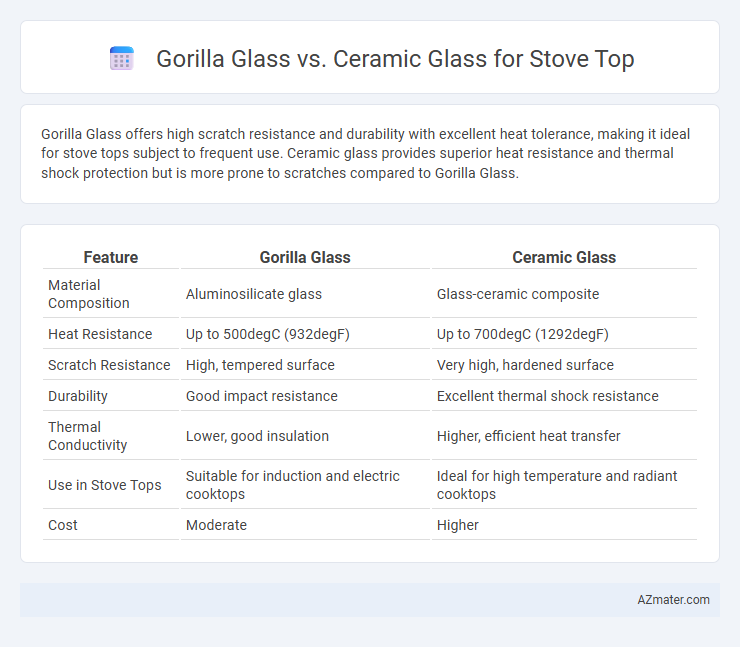Gorilla Glass offers high scratch resistance and durability with excellent heat tolerance, making it ideal for stove tops subject to frequent use. Ceramic glass provides superior heat resistance and thermal shock protection but is more prone to scratches compared to Gorilla Glass.
Table of Comparison
| Feature | Gorilla Glass | Ceramic Glass |
|---|---|---|
| Material Composition | Aluminosilicate glass | Glass-ceramic composite |
| Heat Resistance | Up to 500degC (932degF) | Up to 700degC (1292degF) |
| Scratch Resistance | High, tempered surface | Very high, hardened surface |
| Durability | Good impact resistance | Excellent thermal shock resistance |
| Thermal Conductivity | Lower, good insulation | Higher, efficient heat transfer |
| Use in Stove Tops | Suitable for induction and electric cooktops | Ideal for high temperature and radiant cooktops |
| Cost | Moderate | Higher |
Introduction: Gorilla Glass vs Ceramic Glass for Stove Tops
Gorilla Glass and ceramic glass are two prominent materials used for stove tops, each offering unique properties. Gorilla Glass, known for its exceptional scratch resistance and durability, is chemically strengthened to withstand high impacts and thermal shocks. Ceramic glass provides superior heat resistance and smooth surface aesthetics, making it a popular choice for modern cooktops requiring efficient heat distribution and easy cleaning.
Material Composition: Comparing Gorilla and Ceramic Glass
Gorilla Glass is an aluminosilicate glass renowned for its high strength and durability, enriched with aluminum and potassium ions to enhance scratch resistance and toughness. Ceramic glass, typically made from a blend of silica, alumina, and other oxides, offers superior heat resistance and thermal shock tolerance, making it ideal for stove tops exposed to rapid temperature changes. While Gorilla Glass excels in impact resistance due to its ion-exchange strengthening process, ceramic glass performs better under high heat conditions because of its inherent thermal stability and insulating properties.
Heat Resistance and Thermal Stability
Gorilla Glass offers excellent thermal stability with resistance to rapid temperature changes up to approximately 600degC, making it suitable for use in stove tops where sudden heat fluctuations occur. Ceramic glass outperforms Gorilla Glass in heat resistance, withstanding continuous heat up to 800degC or more while maintaining structural integrity and preventing cracks. The superior thermal shock resistance of ceramic glass ensures safer and longer-lasting stove top surfaces under intense cooking conditions.
Durability and Scratch Resistance
Gorilla Glass, composed of specially formulated alkali-aluminosilicate, offers high durability and exceptional scratch resistance, making it a preferred choice for stove tops exposed to heavy use. Ceramic glass withstands extreme heat effectively but is more prone to scratches and chips compared to Gorilla Glass, reducing its longevity under abrasive conditions. When prioritizing scratch resistance and durability, Gorilla Glass provides superior performance, ensuring a longer-lasting, resilient stove surface.
Aesthetics and Design Options
Gorilla Glass offers a sleek, glossy finish with superior scratch resistance, making it a popular choice for modern stove tops that aim for a high-end, minimalist aesthetic. Ceramic glass provides a smooth, matte surface that integrates seamlessly with various stove designs and allows for custom patterns or colors, offering greater flexibility in kitchen styling. Both materials support innovative designs, but Gorilla Glass tends to emphasize durability with a polished look, while ceramic glass prioritizes design variety and heat resistance.
Cleaning and Maintenance Differences
Gorilla Glass stove tops offer superior scratch resistance and easy wipe-clean surfaces, reducing the need for abrasive cleaning agents. Ceramic glass, while heat-resistant, is more prone to scratches and requires gentler cleaning with non-abrasive sponges and specialized ceramic stove cleaners to maintain its clarity. Regular maintenance of Gorilla Glass involves simple wiping with mild detergent, whereas ceramic glass demands careful attention to avoid residue buildup and maintain its smooth surface.
Safety Features and Shatter Resistance
Gorilla Glass for stove tops offers exceptional shatter resistance due to its chemically strengthened properties, making it highly durable against impacts and thermal shocks. Ceramic glass, while also strong and heat resistant, tends to be more brittle and may crack under severe thermal stress or heavy impact, posing a greater safety risk. For enhanced stove top safety, Gorilla Glass provides superior protection against breakage, reducing the chances of injury and ensuring longer-lasting performance.
Cost Comparison: Gorilla vs Ceramic Glass
Gorilla glass stove tops generally offer a more cost-effective option compared to ceramic glass, with Gorilla glass prices typically 20-30% lower due to its thinner, chemically strengthened composition. Ceramic glass, although more expensive, provides superior heat resistance and durability, justifying its higher cost in premium stove models. The cost difference can impact both initial purchase price and replacement expenses, making Gorilla glass an attractive budget-friendly choice for consumers seeking durability without premium pricing.
Popular Brands and Availability
Gorilla Glass and Ceramic Glass are widely used for stove tops, with popular brands like Corning leading the Gorilla Glass market and Schott dominating ceramic glass production through their Ceran line. Gorilla Glass offers superior impact resistance and scratch protection, making it a preferred choice for modern, durable stove tops, commonly available in mid to high-end models. Ceramic glass remains prevalent for its heat resistance and smooth finish, easily found in a variety of stove brands and widely available in retail and online stores globally.
Which Glass is Best for Your Stove Top?
Gorilla Glass offers superior impact resistance and scratch protection, making it ideal for stove tops exposed to heavy use and accidental knocks. Ceramic glass excels in heat resistance and thermal shock tolerance, providing efficient heat distribution and durability under high-temperature cooking. Choosing the best glass depends on your stove top usage, with Gorilla Glass favored for durability and Ceramic glass preferred for optimal thermal performance.

Infographic: Gorilla glass vs Ceramic glass for Stove top
 azmater.com
azmater.com